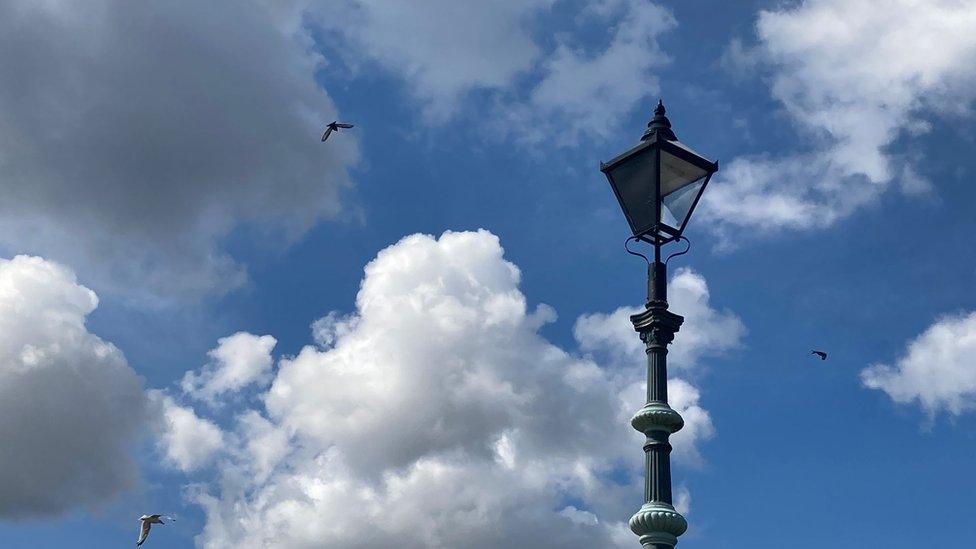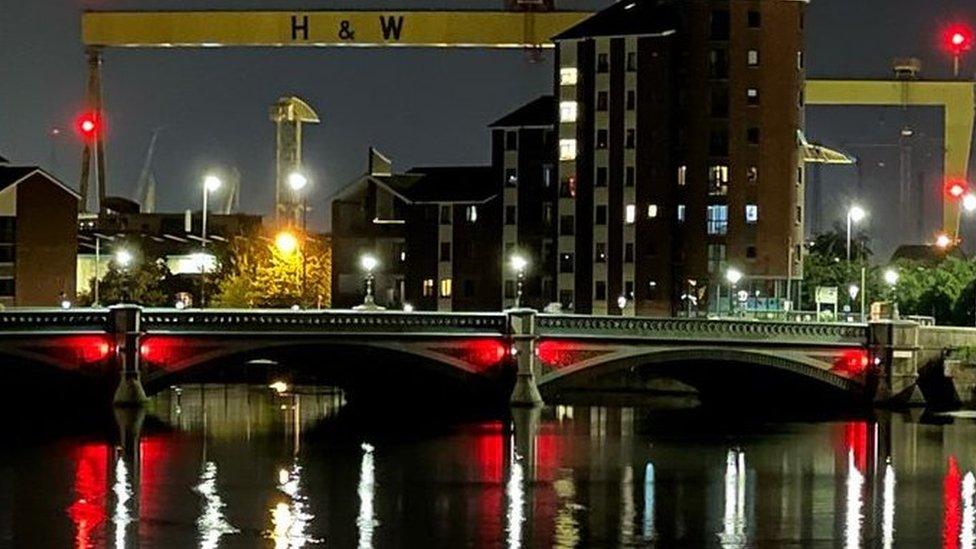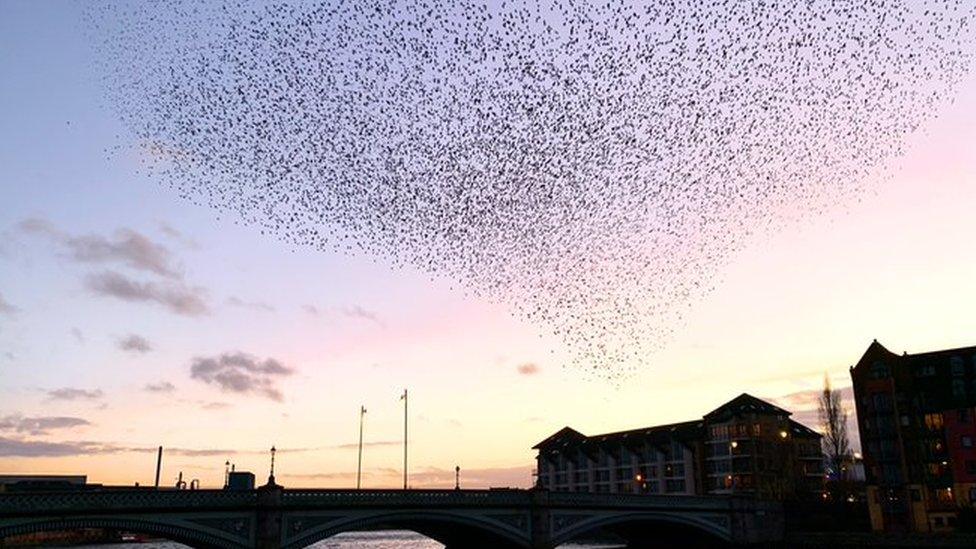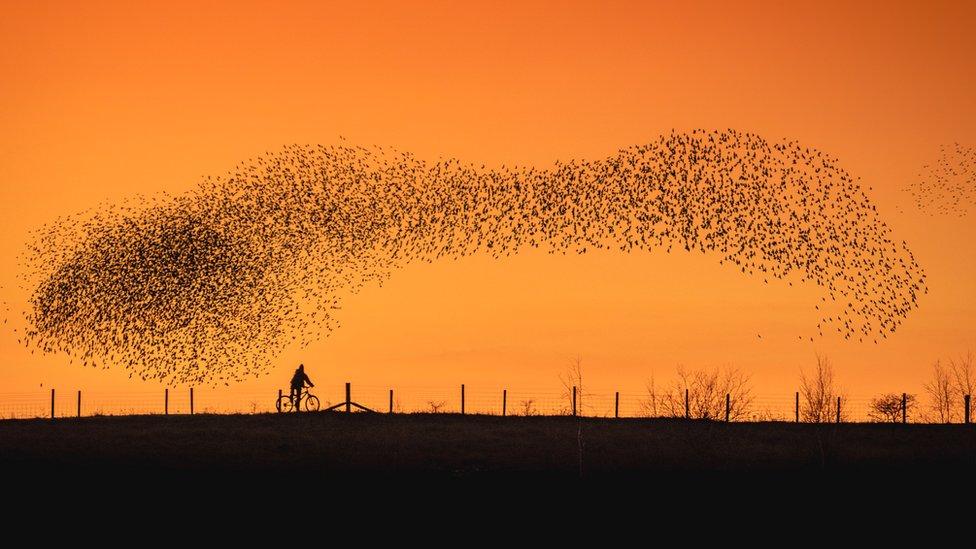Murmuration: Action taken to re-attract Belfast's starlings
- Published

A murmuration is a mass aerial stunt - thousands of birds all swooping and diving in unison together.
Conservationists are hopeful thousands of starlings could return to roost under Belfast's Albert Bridge after moves to reduce light pollution.
Large crowds often gathered to watch and photograph the birds in flight, known as a murmuration.
BBC News NI previously reported the displacement of the birds and concerns changes to street lighting may have played a role.
Blackout screens have now been fitted to lanterns on the bridge.
Conservationist Conor McKinney said the lighting had since been adjusted and he had his "fingers crossed".
Speaking to BBC News NI this week he said: "We now have less lighting on the underside of the bridge.
"We have red filters on the lights on the side of the bridge, and we also have blanking screens on the lanterns at the top of the bridge," he said.

The engraving of starlings on the lamp posts shows how it is recognised that this is an important wildlife site.
The Department for Infrastructure (DfI) - which fitted the blackout screens - is responsible for lighting on Albert Bridge and it was upgraded in 2019, meeting the required British and EU safety and environmental standards.
The Department for Communities (DfC) is responsible for the placement of lights on the under side of the bridge.
When the starlings disappeared, Mr McKinney was concerned this lighting could have contributed to the starling displacement, alongside urban development and climate change.
He told the BBC that "light pollution was leading to the desertion of a very important roosting site".
"As soon as it was reported that the murmuration had not returned in the same numbers as historic years, they (the relevant departments) have paid attention and have now taken action.," he said.

Blanking planes have been fitted to street lamps on Albert Bridge
In a statement this week DfI said it was committed to biodiversity.
"In order to minimise the impact of the parapet mounted decorative lighting in the area of the Albert Bridge, black out screens were fitted to the rear of the lanterns," a spokesperson said.
"This work was completed last weekend."
Following changes to lighting on the underside of the bridge, DfC said it wanted to encourage wildlife in the city.
"DfC, in common with its partners, stakeholders and the wider community on the River Lagan, takes its commitment to biodiversity seriously," a spokesperson said.
"This is in relation to both development on the surrounding banks and stewardship of the river itself, and includes a range of ongoing projects and initiatives to encourage wildlife in the area."

Red light filters have been added to flood lighting on the arch of the bridge. Red light frequency has less impact on starlings

One of Belfast's most amazing sights
A murmuration is the name given to thousands of birds all swooping and diving in unison and the starlings of Belfast even appeared on BBC's Countryfile and The One Show.
There is a variety of reasons, external why they do this; to confuse predatory species, to stay warm and to exchange information about feeding areas.
One of the residents of the apartments overlooking the bridge recalled his disappointment when the starlings didn't return.
"I moved into the area at the start of 2020 when the murmuration was still a massive display across the Belfast skyline," they said.
Swirling starlings gather over Belfast's Albert Bridge in footage from 2019
"One of the main draws to moving into the area was being able to sit at the window at on winter nights watching the starlings fly from across Belfast and beyond to join in the murmuration as they roosted for the night.
"With Harland & Wolff in the background it has always been one of Belfast's most amazing sights."

'We can only watch and wait.'
Will they return? According to the experts, it is a coin toss.
Mr McKinney is hopeful.
"We are still seeing very small numbers of starlings utilising this site in small groups," he said.
"Hopefully that is sufficient to say that whenever larger numbers return to the city, we will begin to see larger groups back here and get the murmuration back up to the size that it was before.
"But we can only watch and wait.
"Moving forward, we need to recognise all of our important wildlife sites and make sure they are mapped and identified with local planning authorities and that they are being seriously considered during every single development."
Related topics
- Published21 February 2023

- Published10 May 2022
